Armstrong Williams Wants Its Eventual Expiration
Journalists at N.Y. Daily News Walk Out
Terry Tang Named L.A. Times Interim Editor
Leisa Richardson Named Editor of 3 S.C. Papers
Right Wing’s Anti-DEI Push Affecting Public Media
J-Groups Back Reporter Arrested at Homeless Camp
$10 Million to Help CUNY J-School Go Tuition-Free
A ‘Conflict Reporter’ Who Cares About the Victims
How Journalism Helped Unpack a Wrenching History
Short Takes: G/O Media and The Root; strongest federal shield legislation; USC ethnic media collaborative; Rev. Dorothy Scott Boulware and Word in Black religion coverage; Kenneth J. Cooper; journalist murders in Haiti; jailed journalists in Cuba, Guatemala and Nicaragua; spyware traces on phones of two Togolese journalists; targeting of journalists in Sudan.
Homepage image credit: Ivy Liu/Digiday
Support Journal-isms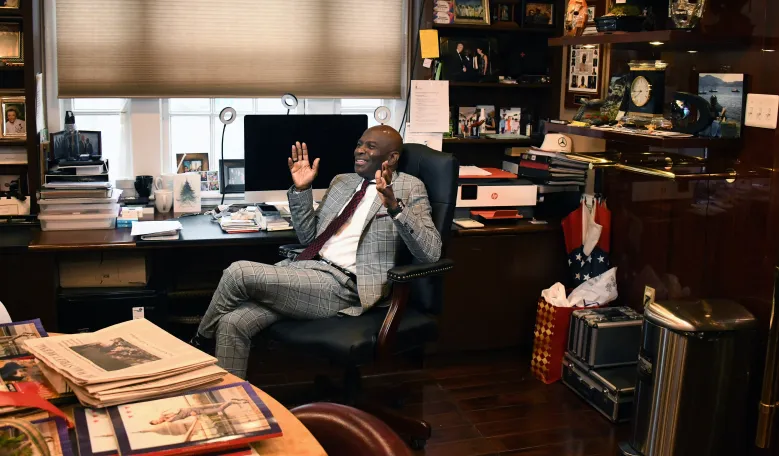
Armstrong Williams Wants Its Eventual Expiration
Armstrong Williams, new part-owner of the Baltimore Sun, visited the newsroom Tuesday, but with none of the headline-making fireworks that accompanied last week’s visit by the chief new owner, Sinclair Executive Chairman David D. Smith.
Williams told Journal-isms by telephone Wednesday that no personnel changes were planned. “The jobs are safe for now. We want stability in the newsroom.” In fact, Williams said the Sun is seeking an investigative reporter, a copy editor and a designer — and that those interested should contact the newsroom.
But then Williams waded into a discussion that has been contentious in other news organizations, saying, “the remote work-from-home is eventually coming to an end.
“No employee works remotely” at the television stations his company owns, he added later. In a news-rich year such as this, the journalists “need to be in the newsroom, exchanging ideas and working together,” and out in the streets. “The news business is 24/7. The media is different from any other institution,” Williams said.
“And there is no compromise on that. No flexibility. I’m very clear on this.”
Not so fast, the News Guild says.
“Our members have appreciated the flexibility to work remotely and have excelled while doing so, so we would expect to negotiate with the company about any changes.” Christine Condon, unit chair and Sun journalist, told Journal-isms.
Williams responded that he has found that unions have been reasonable on this issue. “This is not our first rodeo.”
Still, Condon’s comments have resonance, and not just in newsrooms. A Wall Street Journal headline proclaimed last summer, “Remote Work Sticks for All Kinds of Jobs.”
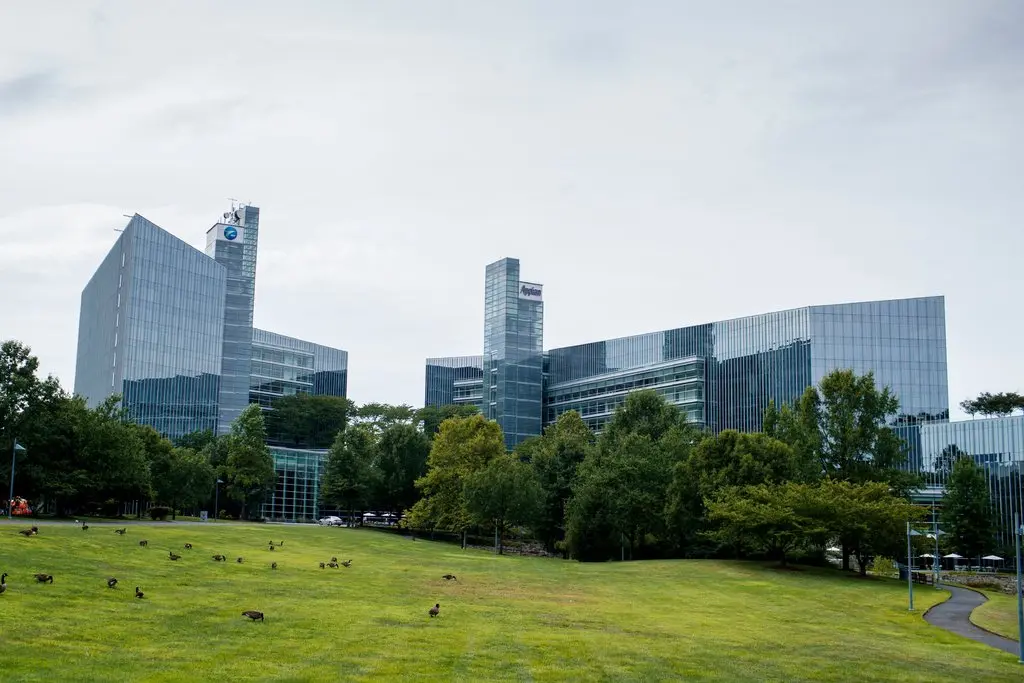 The Gannett Co. has so many of its journalists working remotely for USA Today, based in McLean, Va., a Washington suburb, that they will no longer be required to report to work on the Gannett campus (pictured), a Gannett spokesperson confirmed to Journal-isms Wednesday. They can instead go the Washington, D.C., office, a more central location that for some might be more convenient.
The Gannett Co. has so many of its journalists working remotely for USA Today, based in McLean, Va., a Washington suburb, that they will no longer be required to report to work on the Gannett campus (pictured), a Gannett spokesperson confirmed to Journal-isms Wednesday. They can instead go the Washington, D.C., office, a more central location that for some might be more convenient.
“As we embrace our flexible work model, the company is investing less in underutilized real estate and more in our people and journalism. The USA TODAY team will have the option of working from the DC office,” the spokesperson messaged.
Terence Samuel, USA Today editor, told Journal-isms Thursday that he and top editors would be working from the D.C. office, calling it “a post-pandemic consequence.”
Working remotely is also on the table in contract negotiations at the Daily News in New York. “We have tried to get management to agree to giving remote workers a stipend to offset the costs we incur by being forced to work from home since they closed our newsroom, but so far that has not been accepted,” Ellen Moynihan, Daily News unit chair for the News Guild of New York, told Journal-isms.
The practice of working remotely took root during the height of the COVID epidemic, and many liked it so much that they wanted to keep it once the pandemic waned. They particularly liked the freedom from commuting.
Working remotely was cited as one of the issues in a one-day strike on Dec. 7, 2022, at The New York Times.
In September of that year, “the Times Guild said it had delivered a letter to the news organization’s corporate leadership with the names of nearly 1,300 NewsGuild member employees who have signed a pledge to continue to work remotely this week, the first week the company wants its journalists back in the office,” The Hill reported then.
The Times, in turn, reported on a dispute over the same issue at The Washington Post. Executive Editor Sally Buzbee “has told all newsroom employees that they must work in the office at least three days a week. She has highlighted the benefits of collaborating in person rather than punishing anyone for not coming in,” the Times wrote in June 2022.
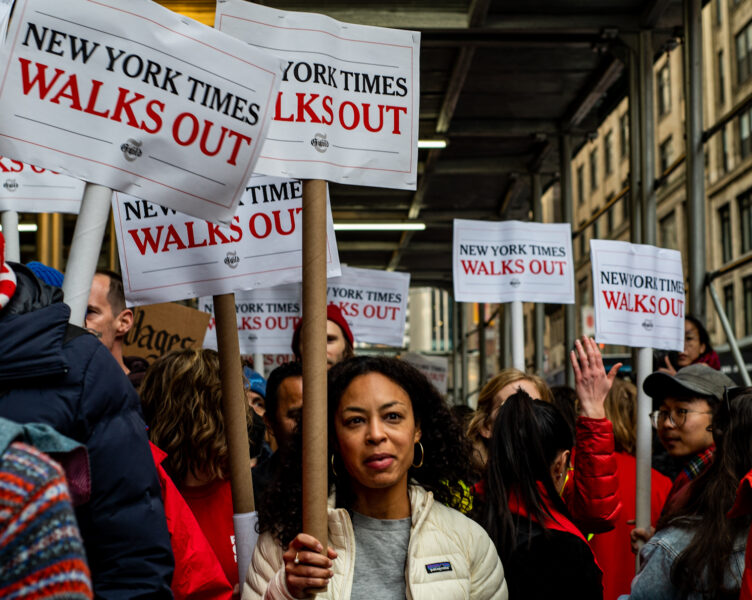
“That return-to-office plan has upset some employees. At least two people who left the newspaper recently said — one publicly, on Twitter, and another in an interview — that the policy had been a major factor in their decision to depart. Some have been reluctant to follow the policy, leading Ms. Buzbee to urge managers to remind their employees to come into the office,” Katie Robertson and Benjamin Mullin wrote for the Times in June 2022.
Current Post policy remains three days in the office, a spokesperson said. As for the Times, “Most of our company works in a hybrid capacity. More days in the office than not but with lots of flexibility. We have a process to apply for full time remote status for some roles. Of course, some roles require being in the workplace (like at the printing plant),” said spokesperson Danielle Rhoades Ha.
Diversity has become part of the equation. At a Journal-isms Roundtable in September 2020, former Denver Post Editor Greg Moore cited the benefits that come with “the combustion of collaborating with other people.”
The newsroom “invites other voices to be part of the process. And not having a newsroom I think really does undercut the impact of diversity,” Moore said. “When those conversations are happening in silos, the opportunity to be invited into those conversations is severely diminished.”
There is also what has been called “proximity bias.” “Some journalists may live in upscale neighborhoods and would experience a wide swath of the city by passing through other neighborhoods to arrive at a newsroom often located in the urban center — though as companies have cashed in on their real estate, some newsrooms have moved away from the action,” Mark Caro reported in October for the Northwestern Local News Initiative at Northwestern University.
Caro quoted Nikki Usher, author of “News for the Rich, White and Blue: What the Decline of Journalism Means for America.” “‘If you’re never being forced to leave your upwardly mobile place, are you really out and about in the city?’ Usher asks. ‘When people aren’t leaving their neighborhoods, that creates a myopia about the issues that matter to cities and counties at large. The Washington Post always runs these leaf-blower stories in the fall….If you’re a journalist in a leaf-blower neighborhood, you should make sure you get some time in a neighborhood where they don’t have leaf blowers. ‘ ”
On the other hand, Feven Merid reported in 2021 for Columbia Journalism Review that some journalists of color had their own reasons for not wanting to go into the office.
“Sometimes, as a Black person working in a newsroom, you feel like you have to constantly be on,” Pierre-Antoine Louis of the Race/Related newsletter and the national desk at the Times, told Merid. “With the uprisings, and George Floyd, I didn’t have to do that last summer, thank God.” Kailyn Brown, an editorial assistant and reporter at the Los Angeles Times, felt the same way: “I report a lot on issues that affect Black and brown people — which is myself, too — and there’s days that you don’t want to talk.”
Smith’s visit to the Sun newsroom last week inspired headlines such as Nieman Lab’s “The Baltimore Sun explores the question of whether there can be a worse newspaper owner than Alden Global Capital.”
“Smith was dismissive of the Sun’s journalism, saying it wasn’t publishing enough stories that readers were interested in, saying there was fraud in local government and schools,” NPR’s David Folkenflik reported on X. “He claimed he had read the paper just four times. He grew up here; his family’s local TV empire — Sinclair — is based in Baltimore Co.”
Williams struck a different tone Tuesday, saying he wanted the Sun journalists to work as a team. He said he met for two hours individually with the top five news managers, and then for 45 minutes with staff members. The absence of drama was the reason the visit received scant coverage, Williams surmised, even though Smith was also present.
“We had a productive conversation yesterday. And we are working on developing some good ideas going forward,” Trif Alatzas, the publisher and editor-in-chief, messaged Journal-isms.
- Michael Barbaro, Emma Goldberg, Sydney Harper, Will Reid, Mooj Zadie, Patricia Willens, Dan Powell, Diane Wong, Elisheba Ittoop and Alyssa Moxley, “The Daily,” New York Times: “The Hybrid Worker Malaise” (podcast)
- Federica Cherubini, Nic Newman and Rasmus Kleis Nielsen, Reuters Institute: Changing Newsrooms 2021: hybrid working and improving diversity remain twin challenges for publishers (Nov. 11, 2021)
- Steve Hemsley, Digiday: Businesses grapple with how to avoid proximity bias when offices reopen (March 31, 2021)
- Lorraine Mirabella, Baltimore Sun: After Baltimore Sun sale to David Smith, part-owner Armstrong Williams offers vision
- Lee O. Sanderlin, Baltimore Banner: Sinclair exec, Sun owner David Smith behind lawsuit against Baltimore schools
- Zachary M. Seward, Quartz: What we’ve learned after one month of operating a hybrid office (July 6, 2021)
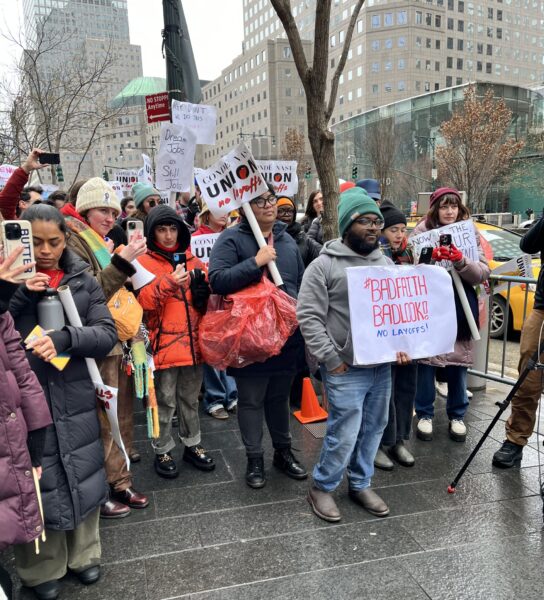
Journalists at N.Y. Daily News Walk Out
“Journalists at New York’s Hometown Newspaper, the Daily News, are walking out Thursday — the first walkout since the end of their historic strike in 1991 — fed up with chronic cuts ordered by the paper’s owner, the ‘destroyer of newspapers’ Alden Global Capital,” the News Guild of New York announced Thursday morning.
“Clicking on Daily News online content during the 24-hour work stoppage is the equivalent of crossing a picket line.
“The 24-hour work stoppage will include an in-person picket beginning at 10 a.m. and rally at noon at 1412 Broadway. The location is outside Workville, a co-working space that is the company’s substitute for a newsroom since they closed the Daily News’ offices in 2020.
“ ‘Alden wants to act as if we are not being chiseled,’ said union steward Michael Gartland, an award-winning reporter who’s covered three NYC mayors. ‘We’re not going to engage in that intellectual dishonesty. In reality, we’re being crushed for cash. As a result, staff is diminished, which means our ability to cover the city is diminished. We believe this is bad for New York.’
“That cash extraction extends even to the way Daily News journalists are paid as they are trying their best to cover a city of over 8 million. The News once boasted the ‘Largest Circulation in America;’ and was 4,000 employees strong. By the year 2000, circulation dropped by nearly half and the publication underwent several rounds of devastating job cuts. Since the spring of 2022, 27 people have left and the Guild-represented staff now totals 54 people. . . .”
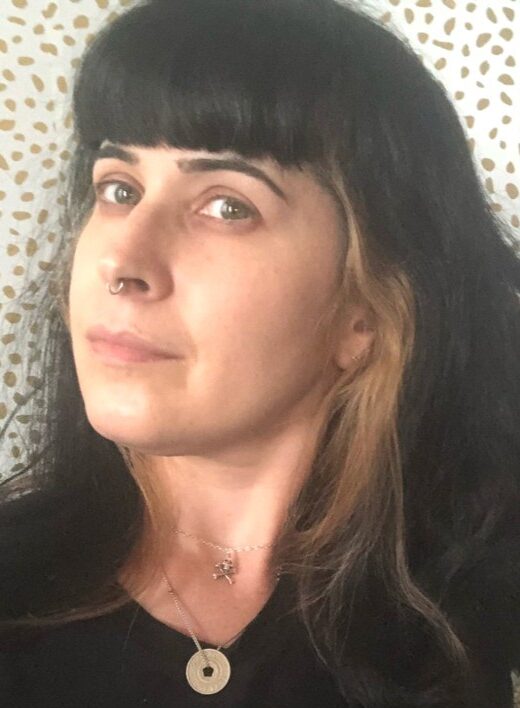 Ellen Moynihan (pictured), Daily News unit chair for the News Guild of New York, messaged Journal-isms Thursday that diversity is part of the discussion.
Ellen Moynihan (pictured), Daily News unit chair for the News Guild of New York, messaged Journal-isms Thursday that diversity is part of the discussion.
“In August we secured a TA (tentative agreement) on a DEI proposal,” Moynihan said.
“Upon ratification of our contract, we will be forming a Labor-Management Diversity, Equity and Inclusion Committee with members of our union and management that will meet at least twice a year to discuss DEI issues, and for employees to make recommendations to management to address diversity at the paper.
“The company has also agreed to send job postings to professional associations and schools serving groups who are traditionally underrepresented in newsrooms, and at least once a year, management will compile data on the diversity of the unionized staff at the Daily News and share it with the Guild.
“The company has also agreed to refer to employees, in print and in personal dealings, by their chosen pronouns and names. Within a week of notifying the company of a name change, the company will update bylines and bios.”
- The City: LISTEN: Daily News Staffers Explain Why They’re Walking Out (podcast)
- Oliver Darcy and Jon Passantino, CNN: News industry off to brutal 2024 start as mass layoffs devastate publishers, raising questions about the future of journalism
- Angela Fu and Tom Jones, Poynter Institute: Tuesday was a bleak day for the media industry
- Katie Robertson, New York Times: Journalists at New York Daily News Walk Off Job for a Day
Terry Tang Named L.A. Times Interim Editor
Terry Tang, editor of the Los Angeles Times editorial page, will add interim executive editor to her title, owner and Executive Chairman Patrick Soon-Shiong announced Thursday.
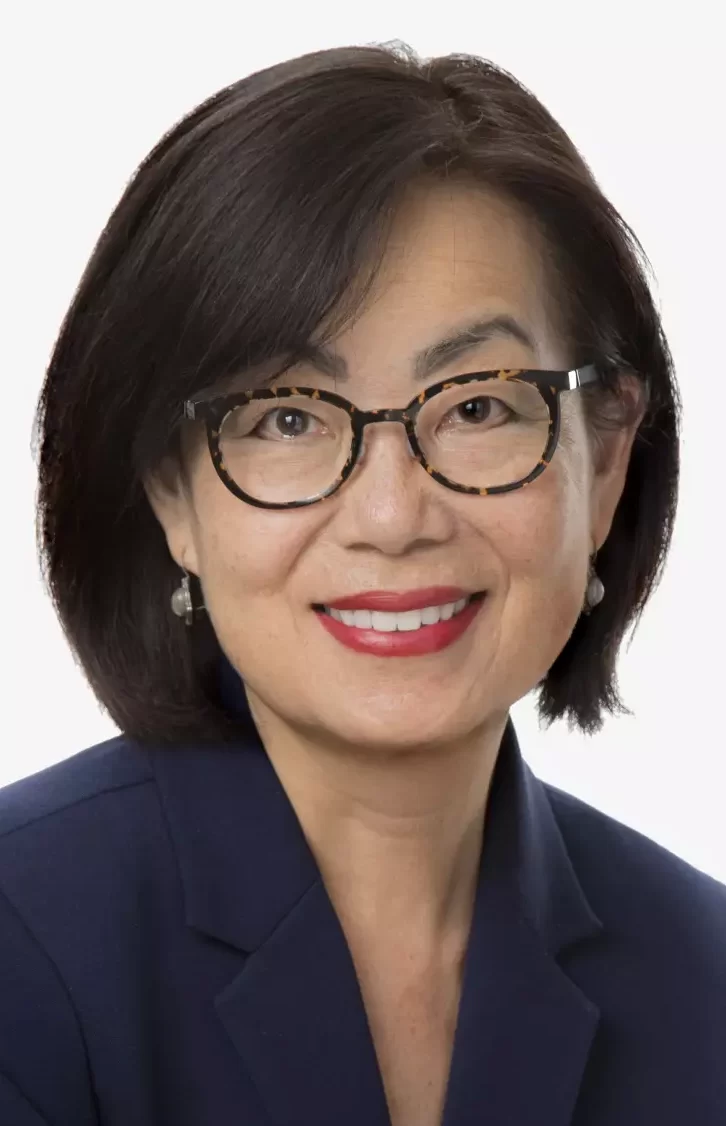 Tang (pictured), filling the vacancy created by the Jan. 12 departure of Kevin Merida, “will immediately begin working to identify a managing editor and organize the newsroom leadership team, and will continue working with Deputy Editorial Page Editor Mariel Garza, who leads the editorial board, and Deputy Op-Ed Editor Susan Brenneman, for op-ed,” the announcement said.
Tang (pictured), filling the vacancy created by the Jan. 12 departure of Kevin Merida, “will immediately begin working to identify a managing editor and organize the newsroom leadership team, and will continue working with Deputy Editorial Page Editor Mariel Garza, who leads the editorial board, and Deputy Op-Ed Editor Susan Brenneman, for op-ed,” the announcement said.
“Under Terry, Opinion has exemplified the critical role that the L.A. Times’ voice plays — to our city, and to the world — in bringing attention to issues that matter most, especially for those whose voices are often unheard,” Soon-Shiong said in the news release.
“Tang joined the L.A. Times in 2019 and has served as editorial page editor since 2022.
“Before that, Tang served as director of publications and editorial at the American Civil Liberties Union. Prior to that, she worked at the New York Times for 20 years in many positions: as deputy editorial page editor; op-ed editor; assistant editorial page editor; editorial writer; deputy technology editor; metro desk major beats editor; and co-founder and editor of Room for Debate, an online platform for rapid-response commentary. She got her start as a journalist in Seattle, where she worked as an editorial writer and columnist at the Seattle Times and a reporter at the Seattle Weekly.”
Meanwhile, “LA Times guild members met with management on Wednesday to try to create order from the chaos of the bloodiest layoffs in decades at the nation’s largest West Coast newspaper,” Alexei Barrionuevo, Sharon Knolle and Natalie Korach wrote Thursday for The Wrap.
“Even at midnight on Wednesday, the turmoil continued as the guild informed members of additional cuts. ‘In one of the most bizarre days of bargaining we’ve experienced, the company unexpectedly raised its layoff target and sent out five more layoff notices Wednesday night – then as midnight neared and we raised protests for our affected colleagues, signaled these notices might not be final,’ read the note, obtained by TheWrap.
“That note followed a day full of tension and anger. . . .”
- Cameron Joseph, Columbia Journalism Review: The Death of the Washington Bureau (Jan. 26)
- Ryan Mac, Benjamin Mullin and Katie Robertson, New York Times: Los Angeles Times Owner Clashed With Top Editor Over Unpublished Article (Jan. 26)
- Hanaa’ Tameez, Nieman Lab: Questions about diversity and seniority swirl after LA Times layoffs
Leisa Richardson Named Editor of 3 S.C Papers
 In January 2019, Leisa Richardson (pictured) took early retirement from the Indianapolis Star, where she held several editing positions. “My hope is to continue the ride. I’m turning a page not closing the book. Stay tuned!” she wrote.
In January 2019, Leisa Richardson (pictured) took early retirement from the Indianapolis Star, where she held several editing positions. “My hope is to continue the ride. I’m turning a page not closing the book. Stay tuned!” she wrote.
It didn’t take long for Richardson to be back in a newsroom. In December of that year, she joined the Gannett Co.-owned State Journal-Register in Springfield, Ill., as executive editor.
And on Monday, Gannett announced that on Feb. 19, Richardson is becoming executive editor of South Carolina’s Greenville News, Spartanburg Herald-Journal and Anderson Independent Mail, beginning Feb. 19.
“Leisa is a proven leader who drives success and inspires journalists to be the best in the business,” said Mark Russell, Gannett and USA Today Network vice president and south region editor. “We look forward to welcoming her to Greenville and all the talent and insight that she brings.”
Savannah Moss reported for the Greenville News, “Richardson has worked as a reporter and editor for several Gannett publications including the Indianapolis Star, Cincinnati Enquirer, and USA TODAY. Receiving multiple awards for her work, she is a lifetime member of the National Association of Black Journalists (NABJ) and has served two terms on the organization’s board of directors, along with representing NABJ on the board of UNITY Journalists of Color.” She has also been program chair of subsequent NABJ conventions.
“Richardson is also a past president of the Indianapolis Association of Black Journalists, and a founding member and past president of NABJ/Cincinnati.
“She studied journalism at Ball State University and newsroom management at Maynard Institute for Journalism Education at Northwestern University’s J.L. Kellogg Graduate School for Business Management, Medill School of Journalism.”
When Richardson went to Springfield, she wrote on Facebook, “Life alert: My brother Jeff recently told me I didn’t know how ‘to do retirement.’ He was right.”

Right Wing’s Anti-DEI Push Affecting Public Media
KUT Radio in Austin, Texas, “had been working to bolster its workplace culture in recent years, but a new law has stymied those efforts,” Tyler Falk reported Wednesday for Current.
“Last year, Texas’ state legislature passed Senate Bill 17, which bans various diversity, equity and inclusion efforts at public universities. The law went into effect Jan. 1.
“ ‘The biggest impact for us is, first of all, the training issue, because we had been doing a lot of training,’ said CEO Debbie Hiott. The new law bans mandatory DEI training.
“The Texas law is part of a broader attack by Republican lawmakers and conservative institutions on DEI efforts at universities and in corporate America. At least five states have passed laws that follow a model proposed early last year.
“The laws have banned measures at public universities such as the posting of diversity statements, the creation of DEI offices, hiring DEI staff, requirements for diversity training, and identity-based hiring preferences, according to the Chronicle of Higher Education, which has been tracking the bills. Legislatures in more than 20 states have considered similar bills.
“While the bills do not directly target public media, many stations are licensed to public universities. In states where anti-DEI laws have passed, stations licensed to public universities must comply with the legislation.
“Public media leaders vary in their reactions to the laws. Some downplay the laws’ impact, while others say they’re concerned that the laws will curtail DEI work.
“ ‘If we can assume that this larger societal trend to demonize DEI continues, then our journalists across the country, whether in the states with laws being passed or not, will be confronting a more difficult road to achieving the kind of fairness, accuracy and completeness that DEI is about,’ said Keith Woods, NPR’s chief diversity officer. . . .”
Meanwhile, the Asian American Journalists Association, which initially touted barbecue as a reason to attend its Aug. 7-11 convention in Austin, Texas, announced a more substantive convention theme: “Meeting the Moment.”
“It recognizes that amid tough times, our work as Asian American and Pacific Islander journalists is more important than ever. We encourage attendees to be fully present as we gather in the Texas state capital during an election year to engage with what’s happening right now — and what’s set to happen — in journalism, politics, and society,” the association said.
- Marcela Rodrigues, Dallas Morning News: UT eliminates scholarship, program for undocumented students following Texas’ DEI ban
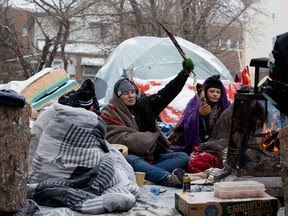
J-Groups Back Reporter Arrested at Homeless Camp
The Indigenous Journalists Association and the Canadian Association of Journalists are lining up in support of freelance journalist Brandi Morin, who was arrested by Edmonton police Jan. 10 while conducting interviews at a downtown homeless encampment. Morin was charged with obstruction, fingerprinted and released on a promise to appear in court on Feb. 1.
The Canadian group said, “Within the past month, multiple Canadian journalists have been arrested or forcibly detained while reporting from the field.“
The IJA said, “Indigenous journalists must be free to report on our communities and share our peoples’ voices, on our traditional territories. Storytelling is our inherent right and an integral part of our right to self-determination, which must be recognized by colonial entities.”
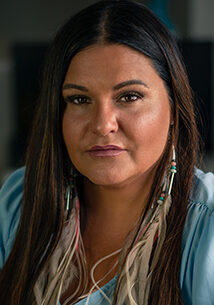 Morin (pictured) is a mother of four and a winner of the Edward R. Murrow Award and the PEN Canada Freedom of Expression who has been recognized by Amnesty International for her Indigenous stories. She was incarcerated for five hours, Jackie Carmichael reported Jan. 11 for the Edmonton Journal.
Morin (pictured) is a mother of four and a winner of the Edward R. Murrow Award and the PEN Canada Freedom of Expression who has been recognized by Amnesty International for her Indigenous stories. She was incarcerated for five hours, Jackie Carmichael reported Jan. 11 for the Edmonton Journal.
Carmichael quoted Morin saying that Edmonton is home to the second-largest Indigenous population in Canada and noted that “while six per cent of the population are native, nearly 60 per cent of the unhoused population are native.”
Morin attributed their plight to the way Indigenous have historically been treated. “That’s what they did to our people here, whose territory they’re on. They were forcibly removed to reserves, their children were removed to residential schools — they’re still removing kids from their families.
“They’re doing the same thing right now, because our people are living with the fallout of all that trauma. With the crisis that Indigenous people are in, this is not the answer,” she said.
“In a Thursday statement to the Edmonton Journal, [Edmonton Police Service] spokesperson Cheryl Sheppard said as police were attempting to direct occupants of the encampment to leave the site, Morin moved towards a physical struggle occurring during the arrest of a male,” Carmichael reported.
“ ‘She was asked repeatedly to go to the area where all other journalists were stationed for their safety. She refused to comply, and was told she would be arrested for obstruction if she didn’t remove herself from the active work site. Morin was subsequently arrested and charged with obstructing a peace officer,’ Sheppard said.
“ ‘The EPS has made extensive efforts to ensure journalists have access to encampment closures. Journalists are allowed to capture footage while standing a safe distance from the work site,’ she said.
“ ‘This is done to protect them from the unpredictable hazards of an encampment cleanup, such as explosions, fire, biohazards and weapons concerns. Exceptions were made for a fire and a sudden death, when journalists and members of the public were asked to move away to allow emergency personnel to do their work.’
“Her publisher, Ethan Cox of Ricochet Media, responded to the arrest.
“ ‘We’re very concerned that the Edmonton police would arrest somebody who identified themselves as a journalist.’ ”
“It’s important for philanthropists everywhere to do what they can to get behind public education in all forms,” says Craig Newmark. “This kind of access really matters.” (Credit: YouTube)
$10 Million to Help CUNY J-School Go Tuition-Free
“The Craig Newmark Graduate School of Journalism at the City University of New York on Thursday set itself on a pioneering path toward free tuition for all of its students with the announcement of a $10 million launch gift from Craig Newmark Philanthropies (CNP),” the school announced.
“The gift boosts the Newmark J-School’s core endowment to $30 million and will allow half the class starting in August 2025 to study for free. The school aims to raise an additional $30 million from donors by the end of 2026, its 20th anniversary year, to become the first top-tier graduate journalism school in the United States to offer fully free tuition in perpetuity to its entire student body.
“If we believe journalism is public service, a service that is essential to our democracy, then we need to eliminate the barriers that stand between the people who want to go into journalism and a successful career in news media,” said Graciela Mochkofsky, dean of the Newmark J-School. “The first barrier is a lack of access to an excellent journalism education, and the Newmark J-School is determined to lead the way in eliminating it. Our beleaguered industry and profession demand it.”
Kunle Adebajo’s story for the International Centre for Investigative Reporting, “Information, Foreign Affairs & Science: 20 Ministries You Should Not Bother E-mailing,” was judged the best report in the Telecommunications and ICT Reporting Category at the 2019 West Africa Media Excellence Conference & Awards. (Credit: YouTube)
A ‘Conflict Reporter’ Who Cares About the Victims
“Kunle Adebajo is a Nigerian investigative journalist and the Investigations Editor at HumAngle, a media platform with a focus on covering conflict and humanitarian issues in Nigeria and other countries in Africa,“ Patrick Egwu wrote Friday for the Reuters Institute.
“Adebajo has covered conflict and issues around insurgency in northeast Nigeria. His reporting has focused on victims of Boko Haram and how they’ve been displaced from their homes and farms. In March 2023, he was announced as the winner of the 2023 Michael Elliot Award for Excellence in African Storytelling for a story which took a deep dive into the lives of some of the students who were abducted by the Boko Haram terror group in 2014.”
Egwu asked Adebajo, “What five lessons have you learnt from reporting on conflict and humanitarian issues?”
The response: “War is a terrible thing. The reality of war itself is horrifying. But even after the gun barrels have gone cold, its effects ripple wide and run deep. It is important to document those effects. It is important to investigate the causes and write about them. People know conflict is bad, but they do not know just how bad. Even a conflict journalist can’t grasp the full extent. And it is important for people to know so that we don’t end up making the same silly mistakes.
“Secondly, it is important to train people to tell their own stories. One of the reasons I became a conflict reporter was that I saw that the bulk of in-depth stories about the Boko Haram conflict were getting published on international platforms headquartered in Europe and North America. It felt wrong. And even though we’ve come a long way since 2020, when HumAngle was established, there is still a huge gulf in capacity that we need to fill.
“The third thing I learnt is that this job requires a certain level of level-headedness. If you want to do it right and do it for a long time, you need to get your facts right, be introspective and willing to self-correct when necessary, and be open-minded to a world of possibilities. You need to understand that the question of what party is right and what party is wrong usually comes down to the specifics. Context is crucial. Conflict and how it is handled is complex, and your narratives must reflect that.
“The fourth thing I learnt is that collaboration is extremely important: between journalists and journalists, between journalists and the state, between journalists and humanitarian actors.
“Finally, if you approach conflict reporting with the mindset that you want to change the world, you may have to reserve a bed in a psychiatric ward. As a journalist, you have to convince yourself that being able to document the evidence and the events as best as you can is itself a win, and there’s really little you can do to improve the lives of the many people you speak to.
“But then again, as Apple famously said in its Think Different commercial, ‘The people who are crazy enough to think they can change the world are the ones who do.’ One thing that has occupied my mind lately is how journalists can tilt the odds slightly in favour of the people they write about so that when they publish their stories, they do not see that as their final bus stop. What extra steps can we take to make sure we are not just piling up bylines but also impacts?”
How Journalism Helped Unpack a Wrenching History
“In 1859, the Commonwealth of Virginia finally forced my great-great-grandfather, William Williamson, to make an almost unfathomable choice — whether he would leave Virginia and keep his freedom or return to slavery so he could remain near his wife and children,” (scroll down) Bobbi Bowman wrote in 2018 for the Lynchburg (Va.) News & Advance, republished in the Richmond (Va.) Times-Dispatch.
Bowman also wrote, “Between 1850 and 1859, Grandpa battled a Virginia law and the vicious choice it imposed on him: Leave Virginia and remain a free man or give up his freedom to stay with his wife and eight children, who were slaves.
“The story of this fearsome choice illustrates how enslaved black people used Virginia law to fight for their freedom and their families. And, it is a story of family love, kindness, friendship and even trust between blacks and whites living under the brutality of slavery. . . .”
Bowman has worked at The Washington Post, the Gannett Co. and the American Society of News Editors, among other organizations. “It’s a lot like reporting a story,” she told Journal-isms then of her research. “I used all the skills they taught us at the Post about how to find information in a courthouse.”
Since then, Bowman has taken writing classes at George Mason University and completed much of her research. On Saturday, she shared the results in a Zoom session with the Afro-American Historical and Genealogical Society’s James Dent Walker Chapter, based in the District of Columbia. She was a hit. “Excellent presentation — inspiring and highly informative,” one wrote in the chat room. I love how you talk about asking your ancestors for guidance as you go about your research.” “Wonderful story of discovery – what great research!’ said another.
You can watch above.
- WSLS-TV, Roanoke, Va.: Two families connected by slavery connected years later (Sept. 14, 2019) (video)
- Valencia Jones & Kirkland Gee, WSET-TV, Lynchburg, Va: Families connected by slavery meet for the first time in Campbell Co. (Sept. 13, 2019)
Short Takes
- Digital media company G/O Media, whose properties include The Root, Deadspin, Quartz, Kotaku, The Onion and Gizmodo, “is shopping around its portfolio of editorial assets in hopes of securing buyers for individual titles,” Mark Stenberg reported Wednesday for Adweek. It is “part of a broader effort to divest the properties ahead of another challenging year for the media industry, according to four people familiar with the efforts.” The media company “initially sought a suitor that would acquire its entire stable of brands, according to two sources. But no such buyer materialized, leading the company to explore options to sell the properties on an individual basis.”
- For the second time in as many Congresses, the House of Representatives passed last week, without objection, the strongest federal shield legislation proposed to date, Gabe Rottman reported Monday for the Reporters Committee for Freedom of the Press. “The bill, H.R. 4250, would bar the federal executive agencies and courts from forcing reporters to identify confidential sources or disclose sensitive newsgathering material, except in very limited circumstances. . . . As for next steps, the bill is now on to the Senate, where it stalled last Congress after Sen. Tom Cotton (R-Ark.) objected to a motion from lead sponsor Sen. Ron Wyden (D-Ore.) to have the bill pass under ‘unanimous consent.’ (While an Army infantry officer in 2006, Cotton wrote an open letter critical of The New York Times’s disclosure of a secret surveillance program involving the SWIFT financial network.) . . . “
- “The USC Center for Health Journalism and partner newsrooms launched our first ethnic media collaborative last week, bringing together eight California outlets serving Black, Latino and Asian audiences,” Michelle Lavender wrote Wednesday for USC. “The news venture aims to reflect California’s potential without shying away from its health and equity challenges. . . .”
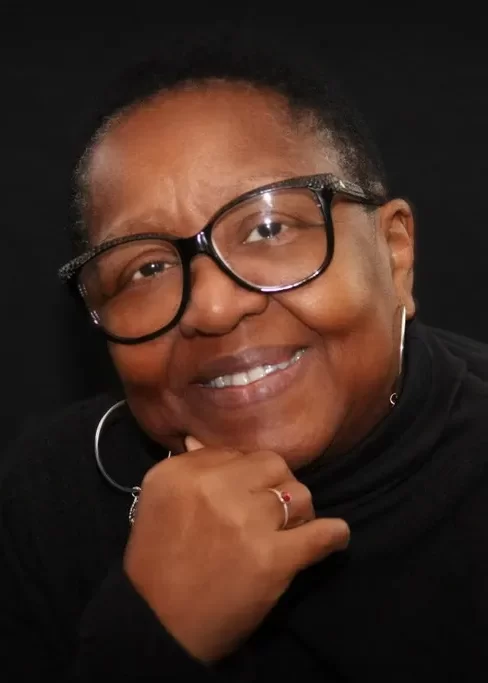 Word in Black, “a groundbreaking collaboration of the nation’s legendary Black publishers and a program managed by Local Media Foundation, has received a $300,000 grant from the Henry Luce Foundation to establish a religion and social justice desk,” the Local Media Foundation announced. “This funding will allow Word In Black to delve into the intersection of race, religion, and social justice within the Black community, as well as the Black youth perspective. These stories will humanize what audiences are experiencing and offer religious-based solutions. Word In Black has hired an award-winning journalist and editor, Rev. Dorothy Scott Boulware (pictured), for this new position. . . .”
Word in Black, “a groundbreaking collaboration of the nation’s legendary Black publishers and a program managed by Local Media Foundation, has received a $300,000 grant from the Henry Luce Foundation to establish a religion and social justice desk,” the Local Media Foundation announced. “This funding will allow Word In Black to delve into the intersection of race, religion, and social justice within the Black community, as well as the Black youth perspective. These stories will humanize what audiences are experiencing and offer religious-based solutions. Word In Black has hired an award-winning journalist and editor, Rev. Dorothy Scott Boulware (pictured), for this new position. . . .”
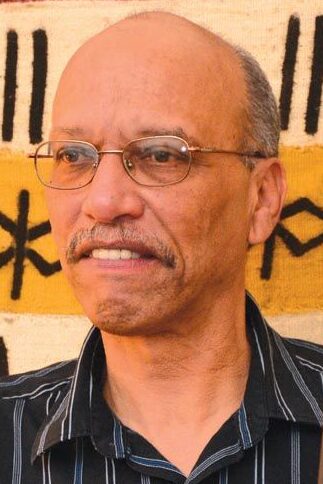 “The Washington University Libraries recently acquired the Kenneth J. Cooper Papers, an archival collection of materials related to the life and work of WashU alum and Pulitzer Prize-winning journalist Kenneth J. Cooper (pictured),” a 1977 graduate, the university announced Tuesday. “The collection includes over twenty linear feet of Cooper’s personal and professional material, including material from his time as a student at WashU, research and drafts of his articles and books, material from his time as a Fulbright Scholar and Harvard Fellow, and material from his travels. . . . He has been a journalist for nearly half a century, specializing in government, politics, and social policy, at the Washington Post, Boston Globe, Knight Ridder, GBH News, St. Louis Post-Dispatch, and St. Louis American. . . . “
“The Washington University Libraries recently acquired the Kenneth J. Cooper Papers, an archival collection of materials related to the life and work of WashU alum and Pulitzer Prize-winning journalist Kenneth J. Cooper (pictured),” a 1977 graduate, the university announced Tuesday. “The collection includes over twenty linear feet of Cooper’s personal and professional material, including material from his time as a student at WashU, research and drafts of his articles and books, material from his time as a Fulbright Scholar and Harvard Fellow, and material from his travels. . . . He has been a journalist for nearly half a century, specializing in government, politics, and social policy, at the Washington Post, Boston Globe, Knight Ridder, GBH News, St. Louis Post-Dispatch, and St. Louis American. . . . “
- “Journalist murders decreased in Haiti in 2023 compared to the previous year, but the local press continued to be a victim of crimes, kidnappings, and multiple threats due to high levels of instability and violence prevailing in the country,” Javier Valdivia reported Jan. 3 for the Inter-American Press Association. “The absence of guarantees, the lack of minimum safety conditions, and the high degree of impunity throughout Haiti marked a dark year for the press, which remained committed to its work despite the serious dangers it faces. . . .”
- Although no country in Latin America and the Caribbean is on the 2023 list of “the worst jailers of journalists,” from the Committee to Protect Journalists, “Cuba, Guatemala and Nicaragua are included in the annual report because each country has an imprisoned journalist,” Silvia Higuera reported Jan. 19 for LatAm Journalism Review. “The most notable case is that of journalist José Rubén Zamora, who remains imprisoned in Guatemala despite the fact that a court in the country annulled his six-year prison sentence handed down in June 2023 for alleged money laundering . . . in Nicaragua, the report mentions the case of Víctor Ticay, an independent journalist and correspondent for Channel 10 who was sentenced to eight years in prison on Aug. 15, 2023 for the crimes of ‘treason and false news’” . . .In Cuba, journalist and activist Lázaro Yuri Valle Roca was sentenced on July 28, 2022 to five years in prison for the crimes of ‘continued enemy propaganda.’ . . .”
- “Reporters Without Borders (RSF) has found spyware traces on the phones of two Togolese journalists currently on trial in a defamation case brought by a government minister,” the press-freedom group reported Tuesday. “The traces are typical of Pegasus, the spyware used by Togo’s government until 2021 at least. One of the journalists was subjected to a major cyber-espionage operation throughout the first half of 2021. RSF calls on the authorities to explain. . . . Evidence of at least 23 spyware intrusions between 1 February and 10 July 2021 were identified on one of the phones used by Loïc Lawson, the publisher of Flambeau des Démocrates, a leading independent weekly in Togo. Freelance journalist Anani Sossou was the target of a similar attack on his phone a few months later, on 25 October 2021. . . .”
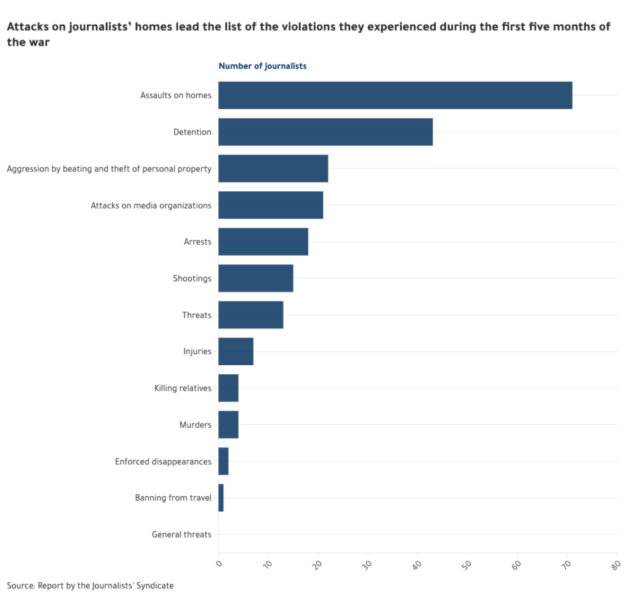
- The ongoing threats against Sudanese journalists — whether in person or online- have led to scribes being either internally or, more often, externally displaced, the Ayin Network reported Sunday, in collaboration with Arab Reporters for Investigative Journalism. “According to the UN, Sudan has the highest rate of displacement in the world – with 6 million people internally displaced and another 1.7 million who have fled across the country’s borders. . . In a survey among Sudanese civilians concerning access to information conducted by Ayin, citizens confirmed that they often rely on phone calls from friends to receive updates since they cannot rely on the local media anymore. Most local media houses are now either shuttered or have become mouthpieces for one of the warring parties, survey respondents told Ayin. This latter phenomenon can, survey respondents said, lead to the prolongation of the war, spreading hate speech – even encouraging geographical separations and social divisions. . . .”
- . . . “In its latest report, the Sudanese Journalists Network (SJN) strongly denounced the targeting of journalists by the Sudan Armed Forces (SAF) and the Rapid Support Forces (RSF) during the war that has been raging for eight months. The New-York-based Committee to Protect Journalists called for the ‘immediate and unconditional release’ of the editor-in-chief of El Midan and his brother held by an RSF unit in Khartoum on Saturday. . .,” Dabanga, “an independent, Sudanese news and information broadcaster,” reported Saturday.
To subscribe at no cost, please send an email to journal-isms+subscribe@groups.io and say who you are.
Facebook users: “Like” “Richard Prince’s Journal-isms” on Facebook.
Follow Richard Prince on Twitter @princeeditor
Richard Prince’s Journal-isms originates from Washington. It began in print before most of us knew what the internet was, and it would like to be referred to as a “column.” Any views expressed in the column are those of the person or organization quoted and not those of any other entity. Send tips, comments and concerns to Richard Prince at journal-isms+owner@
View previous columns (after Feb. 13, 2016).
View previous columns (before Feb. 13, 2016)
- Diversity’s Greatest Hits, 2018 (Jan. 4, 2019)
- Book Notes: Is Taking a Knee Really All That? (Dec. 20, 2018)
- Book Notes: Challenging ’45’ and Proudly Telling the Story (Dec. 18, 2018)
- Book Notes: Get Down With the Legends! (Dec. 11, 2018)
- Journalist Richard Prince w/Joe Madison (Sirius XM, April 18, 2018) (podcast)
- Richard Prince (journalist) (Wikipedia entry)
- February 2018 Podcast: Richard “Dick” Prince on the need for newsroom diversity (Gabriel Greschler, Student Press Law Center, Feb. 26, 2018)
- Diversity’s Greatest Hits, 2017 — Where Will They Take Us in the Year Ahead?
- Book Notes: Best Sellers, Uncovered Treasures, Overlooked History (Dec. 19, 2017)
- An advocate for diversity in the media is still pressing for representation, (Courtland Milloy, Washington Post, Nov. 28, 2017)
- Morgan Global Journalism Review: Journal-isms Journeys On (Aug. 31, 2017)
- Diversity’s Greatest Hits, 2016
- Book Notes: 16 Writers Dish About ‘Chelle,’ the First Lady
- Book Notes: From Coretta to Barack, and in Search of the Godfather
- Journal-isms’ Richard Prince Wants Your Ideas (FishbowlDC, Feb. 26, 2016)
- “JOURNAL-ISMS” IS LATEST TO BEAR BRUNT OF INDUSTRY’S ECONOMIC WOES (Feb. 19, 2016)
- Richard Prince with Charlayne Hunter-Gault, “PBS NewsHour,” “What stagnant diversity means for America’s newsrooms” (Dec. 15, 2015)
- Book Notes: Journalists Follow Their Passions
- Book Notes: Journalists Who Rocked Their World
- Book Notes: Hands Up! Read This!
- Book Notes: New Cosby Bio Looks Like a Best-Seller
- Journo-diversity advocate turns attention to Ezra Klein project (Erik Wemple, Washington Post, March 5, 2014)

